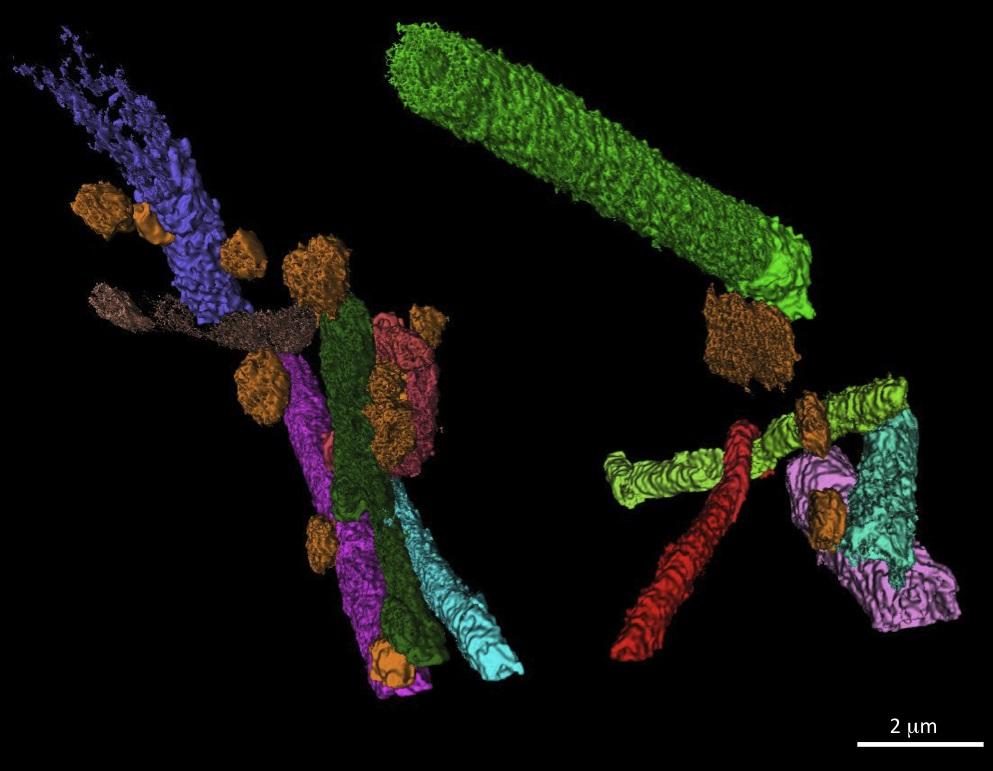Research Overview
See what projects the Early Earth and Biosignatures theme is working on now! (Updated June 2014)

Hovedinnhold
Twenty thirteen was an exciting year for the Early Earth and Biosignatures theme with progress on wide ranging topics. These research activities spanned almost the entire geological timescale, from Archean 3.45 billion-year-old rocks to modern geobiological field sites.
Our research also spanned many different spatial scales, from field and drill core investigations of geological relationships, to micro and nanoscale studies of geochemical signatures. Our approach of combining information from multiple spatial and temporal scales is essential to our goals of identifying traces of life or so-called biosignatures in deep time, and to reconstructing ancient Earth processes.
Efforts to develop nanoscale methods for analyzing ancient biosignatures were very successful in 2013. In recent seafloor rocks, focused ion beam technology at the Norwegian nanolab is being used to investigate alteration processes that may be microbially mediated. In deep time, a study by Wacey et al. 2013 combined 3-dimensional reconstruction methods with nanoscale sulfur isotope analysis by nanoSIMS to investigate a 1.9 billion-year-old fossilized microbial community. This found unprecedented evidence of heterotrophic microbes consuming the organic remains of other microorganisms, which was reconstructed in unprecedented three-dimensional detail by nano-meter scale serial slicing and imaging of the fossilized microbes.
Work on early Archean Earth environments and processes continued apace in 2013. A key publication presented sulfur isotope data from the Barberton Scientific Drilling Project, greatly expanding the global dataset on Archean sulfur isotope values (Grosch and McLoughlin, 2013). In a feature article in this report it is explained how this data was used to generate new insights into the biological, geological and chemical processes that cycled sulfur on the early Earth. In particular, the types of sulfur based microbial metabolisms that were and weren’t present, and also the impact of emerging tectonic processes on the sulfur cycle.
Studies of recent oceanic lavas were published in a photographic atlas in 2013 reporting microscopic alteration textures in subseafloor rocks, intended as a guide to the interdisciplinary research effort to identify markers of microbial activity in the deep subseafloor (Fisk and McLoughlin, 2013). This year the research theme was joined by a new PhD student who will investigate biosignatures of iron-oxidizing bacteria in the Norwegian-Greenland Sea. These microorganisms are very sensitive to the local concentrations of oxygen and the knowledge gained from these modern ecosystems will be used to investigate the rise of atmospheric oxygen in deep time. This major transition in earth history known as the Great Oxidation Event that commenced c. 2.4 billion years ago was the subject of a PhD thesis by Qu Yuangao completed in 2013. This focused on the Shunga event that records vast deposition of organic matter and accumulation of oil in the rock record. Carbon isotope analysis and ultra-structural investigation of the organic matter were combined to study this radical perturbation in the ancient carbon cycle.
In conclusion, 2013 was a diverse and busy year for our theme. Dissemination of our research results also took place at several conferences with presentations and convener activities at all of the following meetings: the European Geophysical Union, the Nordic Astrobiology Conference, and Goldschmidt (Geochemistry) conference. The coming years promise to be equally exciting and rewarding for the Early Earth and Biosignatures theme.
Normal 0 21 false false false NO-BOK X-NONE X-NONE /* Style Definitions */ table.MsoNormalTable {mso-style-name:"Table Normal"; mso-tstyle-rowband-size:0; mso-tstyle-colband-size:0; mso-style-noshow:yes; mso-style-priority:99; mso-style-parent:""; mso-padding-alt:0mm 5.4pt 0mm 5.4pt; mso-para-margin-top:0mm; mso-para-margin-right:0mm; mso-para-margin-bottom:10.0pt; mso-para-margin-left:0mm; line-height:115%; mso-pagination:widow-orphan; font-size:11.0pt; font-family:"Calibri","sans-serif"; mso-ascii-font-family:Calibri; mso-ascii-theme-font:minor-latin; mso-hansi-font-family:Calibri; mso-hansi-theme-font:minor-latin; mso-bidi-font-family:"Times New Roman"; mso-bidi-theme-font:minor-bidi; mso-fareast-language:EN-US;}

